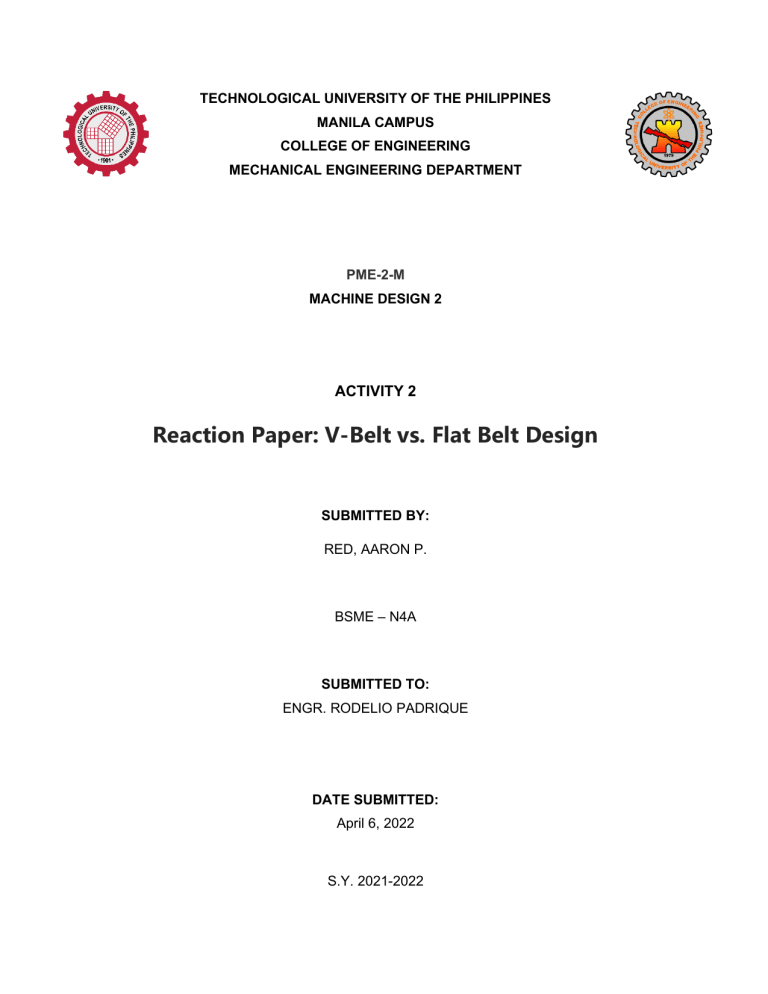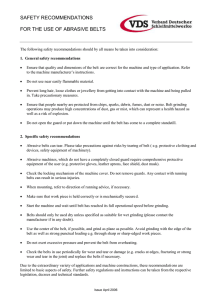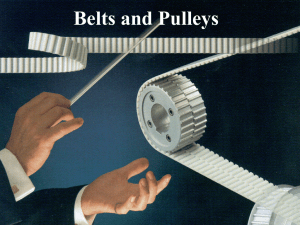
TECHNOLOGICAL UNIVERSITY OF THE PHILIPPINES MANILA CAMPUS COLLEGE OF ENGINEERING MECHANICAL ENGINEERING DEPARTMENT PME-2-M MACHINE DESIGN 2 ACTIVITY 2 Reaction Paper: V-Belt vs. Flat Belt Design SUBMITTED BY: RED, AARON P. BSME – N4A SUBMITTED TO: ENGR. RODELIO PADRIQUE DATE SUBMITTED: April 6, 2022 S.Y. 2021-2022 V – BELTS vs. FLAT BELTS To start the discussion, let us first define what is V – Belt and Flat Belt. A v-belt is a flexible machine component that transfers power between grooved pulleys or sheaves. Belts with a trapezium cross-section are what they're called. Because of its shape, V-belts are the most extensively used belt drives because they wedge snugly into the groove when the tension is increased. The friction between the belt's surface and the groove increases as the belt wedges into the groove, allowing large torques to be delivered. The higher friction reduces power loss due to slippage. While Flat Belts has a rectangular cross-section and its function is to transmit power from one shaft to another at a certain distance. A frictional force is made used for the transmission of power between belt and pulley take place. SIMILARITIES AND DIFFERENCES BETWEEN V – BLETS AND FLAT BELTS IN TERMS OF FORMULAS: At first reading the names of the belts you could already say that their main difference it the flat belts has a rectangular cross-section while v – belts has trapezoidal cross-section. For the formulas of Flat belt and V – Belts, I observed that there are not many differences in the formulas for getting the measurement/value of something. They have the same formula for the following: Torque transmitted by the belt, Rated power, Centrifugal loading, Belt length, and angle of contact. The only difference that I saw is for the computation of the Tension of the belt. FOR THE TENSION OF V – BELT FOR THE TENSION OF FLAT BELTS IN TERMS OF THEIR PROCEDURES: As we all know, these two types of belts’ main function are to transmit power and motion through shafts. Both belts are in contact with the pulley, but the difference is that kind of pulley that they are in contact with. For the flat belt, it is placed parallel to the pulley and has a cylinder shape. While v – belts, pulley has a v groove for the v – angle of the belt will fit in it. Therefore, I think v – belt will have a higher transmission capacity for it has more friction/grip with the pulley. Also, both belts are flexible drive for there is a flexible element which is the belt. Now, for or wedging actions, V – belts compare with Flat belts, I can say that V – belt has an advantage. The v – belts has a larger normal force and tangential force at the same belt tension and coefficient of friction as flat belts. For this reason, the v – belt will result to having a larger tension ratio. Also, v – belts is good for short center distances, because there will be no need for initial tension adjustments like in the flat belts. In v – belts, there are wedging in grooves and pulling out of grooves therefore energy loss and high wear of the belt could happen. While in the flat belts there is no groove required and no pulling in and out of the grooves therefore, no energy is loss and wearing of belt is negligible. Conclusions: Both Flat Belt and V – Belts are very useful in transmitting motion and power. They have their similarities, as well as differences. One can be better than the other in terms of some specifications and vice versa. Regardless of their differences, I think they have their unique characteristics to perform a specific purpose. Also, knowing what type of belt to be use for a specific action to perform is a must for it could affect the performance if we fail to use the specific type of belt for the job.







